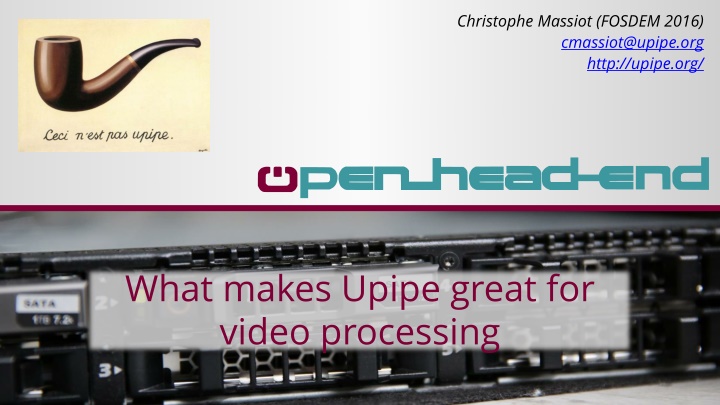
Innovative Video Processing with Upipe
Learn about the outstanding features of Upipe, a cutting-edge multimedia framework developed by the OpenHeadend team. Explore its advanced buffer management, arbitrary metadata attributes, and clock variants to understand why Upipe excels in video processing for professional applications.
Download Presentation

Please find below an Image/Link to download the presentation.
The content on the website is provided AS IS for your information and personal use only. It may not be sold, licensed, or shared on other websites without obtaining consent from the author. If you encounter any issues during the download, it is possible that the publisher has removed the file from their server.
You are allowed to download the files provided on this website for personal or commercial use, subject to the condition that they are used lawfully. All files are the property of their respective owners.
The content on the website is provided AS IS for your information and personal use only. It may not be sold, licensed, or shared on other websites without obtaining consent from the author.
E N D
Presentation Transcript
Christophe Massiot (FOSDEM 2016) cmassiot@upipe.org http://upipe.org/ What makes Upipe great for video processing
What is Upipe? A young (2012) C multimedia framework Initiated by OpenHeadend team 3 supporting companies, 7 contributors Pre-release 4 just out, plans for 1.0 to be discussed Focus on reliability, efficiency and compliance, for broadcast and professional applications MIT and LGPL What makes Upipe great for video processing 2
Upipe main structures struct upipe: unit of data processing, part of a pipeline struct uprobe: internal exception catcher, interaction with application struct upump: external event catcher, event loop struct uclock: system clock management struct urequest: inter-pipe negotiation struct uref: unit of data and metadata struct ubuf: container of data What makes Upipe great for video processing 3
Advanced buffer management Refcounts allow buffer-sharing struct ubuf *new = ubuf_dup(ubuf); Copy-on-write semantics ubuf_block_write(ubuf, offset, &size, &buf); new = ubuf_block_copy(ubuf_mgr, ubuf, skip, What makes Upipe great for video processing new_size); Zero-copy primitives for data blocks ubuf_block_append(ubuf1, ubuf2); ubuf_block_insert(ubuf1, offset, ubuf2); ubuf_block_delete(ubuf, offset, size); ubuf_block_resize(ubuf, offset, new_size); 5
Arbitrary meta-data attributes struct uref carried across pipes embeds timestamps & pointers to ubuf and attribute dictionary Preprocessor macros allow easy attribute declarations: UREF_ATTR_UNSIGNED(foo, bar, foo.bar", example of attribute) Accessors to manipulate the attribute: uref_foo_set_bar(uref, 42); uref_foo_get_bar(uref, &uint64_var); uref_goo_delete_bar(uref); Implemented with inline buffer (no memory allocation) What makes Upipe great for video processing 6
Three clock variants Packet timestamps are stored in three clock variants: orig: original timestamp scaled to 27MHz units prog: same scale as orig but origin moved to be monotonically increasing, used to encode PTS/DTS sys: scale of the system clock (uclock), used to output packets Allows to keep a compliant difference between PTSs based on frame rate (eg. 40 ms) At the same time skew the system clock to output packets faster or slower to keep up with transmitter What makes Upipe great for video processing 7
Inner pipes Pipes can embed other pipes Allows for more granularity and flexibility What makes Upipe great for video processing 8
Event loop Upipe s event loop can be exposed to all pipe types via an abstract API (upump) Allows to have timers in any pipe, for instance event handling (SCTE-35 splicing) upump = upump_alloc_timer(upump_mgr, callback, opaque, refcount, timeout, repeated); Or to interact with the external world upump = upump_alloc_fd_read(upump_mgr, callback, opaque, refcount, file_descriptor); What makes Upipe great for video processing 9
Dynamic pipeline construction The uprobe API allows the application to receive exceptions from the pipe Application can be notified when a pipe needs an output (UPROBE_NEED_OUTPUT), or the list of elementary streams of a demux changes (UPROBE_SPLIT_UPDATE) Useful for dynamic formats such as transport streams What makes Upipe great for video processing 10
Threading & buffering Pipes are low-level threading is decided by the application Queues and workers can move pipelines to threads local_pipe = upipe_wlin_alloc(remote_thread, local_probe, remote_pipe, remote_probe, input_queue_len, output_queue_len); Local pipe takes the place of the remote pipe in the local thread and can be acted upon Lockless FIFOs and LIFOs handle and recycle data structures + eventfd abstraction What makes Upipe great for video processing 11
Inter-pipe negotiation Pipes can register struct urequest on their output The request is passed from pipe to pipe until handled, the reply flows backwards from callback to callback Requests cross threads boundaries via queues and are resent in case of pipeline changes What makes Upipe great for video processing request Pipe 1 Pipe 2 Pipe 3 Pipe 4 data callback thread 2 queue thread 1 12
Available pipes upipe-modules: pipes for basic manipulation and I/O upipe-ts: standards-compliant TS demux and mux upipe-framers: bitstream conversion of common codecs (mp2v, h264, mp2, aac, a52, opus, telx, dvbsub, s302) upipe-av: avformat demux and mux, avcodec decoder and encoder What makes Upipe great for video processing upipe-swresample, upipe-swscale, upipe-x264, upipe-blackmagic 13
Application development Currently C API Work for LuaJIT bindings under way: https://github.com/nto/lj-upipe Transcode example application: Usage: transcode [-d] [-m <mime>] [-f <format>] [-p <id> -c <codec> [-o <option=value>] ...] ... <source file> <sink file> -f: output format name -m: output mime type -p: add stream with id -c: stream encoder -o: encoder option (key=value) What makes Upipe great for video processing 14
What makes Upipe great for video processing cmassiot@openheadend.tv Upipe meet-up in BOF room Sunday 14:00 15
